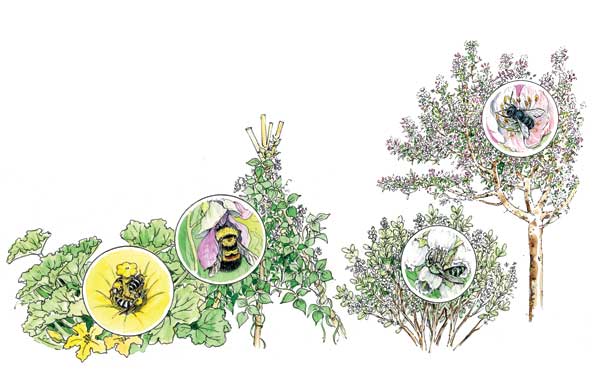Gardeners can benefit from hosting helpful pollinators, which tend to stay put when given food and a place to live. Native bees (including bumblebees, sweat bees, mining bees and others) pollinate many crops more efficiently and completely than honeybees do, with strawberries, blueberries and the entire squash family reliant on local pollinators to produce their best crops.
Tomatoes visited by bumblebees bear bigger fruits, because the big bees’ buzzing action shakes loose more pollen than wind alone. Strawberries pollinated by multiple types of bees yield fewer misshapen berries, and pumpkins pollinated by native squash bees produce larger pumpkins.
Pollinators play a significant role in producing 150 food crops in the United States and, according to the Xerces Society (a nonprofit wildlife conservation group), one in three mouthfuls of our food and drink requires their work.

Bee activity
For about 70 percent of the 4,000 bee species native to North America, home is a secure spot tunneled into the ground (ground nesters). The other 30 percent nest in dead trees and stems (wood nesters). Almost all native bees live alone, not in colonies. Passive by nature, bees won’t usually sting unless squashed or pinched.
Young adult bees emerge from their nests at various times during the year, usually in sync with the blooming period of their favorite crops. Females quickly mate and select good nesting sites, which are often within 1,000 feet of desirable flowering plants. After making a few short flights to learn their new addresses, ground-nesting bees immediately start working to excavate a nest and stock it with eggs. Gathering the necessary pollen, nectar and sometimes mud requires thousands of trips between flowers and the nest. The closer the flowers are to the bees’ nest, the less energy the bees must expend in flight.
Native bees that provide pollination for gardens and orchards
- Bumblebees are the largest native bees, and they also tend to fly the farthest in search of food. Active from spring to fall, they pollinate a wide range of plants and are especially important to legumes. Bumblebees usually nest in the ground or in cavities in trees. Bumblebees are the only native bees that are truly social.
- Mason bees are also called “orchard bees” because they often appear in fruit orchards in spring. These stout, bristly little bees may be black or metallic blue or green. Mason bees use mud to pack their well-provisioned eggs into the hollows of twigs and branches. They frequently accept man-made nesting blocks.
- Mining bees look like slender, miniature honeybees but have long, wasp-like wings. Active early in the year, they are important pollinators of fruit trees. Although mining bees are solitary ground nesters, numerous closely spaced nests may appear in hospitable spots.
- Squash bees are the small black and yellow bees found in cucurbit blossoms, including those of cucumbers, summer squash and pumpkins. Male squash bees sometimes sleep inside the blossoms in hopes of encountering a female. These solitary ground nesters do not emerge until early summer.
- Sweat bees are small and often have metallic backs. You’ll spy them pollinating strawberries, blueberries and a wide range of flowers. Different species are active early and late in the year. They prefer to stay within a quarter-mile of their nests and they live alone, though several nests may be present in a hospitable location.
Making your own bee nesting sites
Some of the best bees for pollinating early-blooming fruits are wood-nesting mason bees. They nest in the soft centers of semi-hollow twigs (such as those of elderberries and bramble fruits) or in holes made in dead trees by beetles or other small insects. Other wood-nesting bees prefer rotting stumps or logs.
If your garden is near open woods that include standing dead trees and rotting logs, you may already have a good population of mason bees and other wood-nesting species. If there are no dead trees around, you can use fence posts or logs as substitutes.
Use a drill to make a number of deep holes in the south side of a fence post or stump. Because different species prefer different sizes of holes, drill them ranging from 3/32 of an inch (2 millimeters) to 5/16 of an inch (8 millimeters) wide. Drilling at a slight upward angle will keep water from entering the holes.
In Europe, many urban parks include insect hotels, which are free-standing structures stocked with habitat for wood-nesting bees and other insects. Envision a deep box artfully filled with hollow stems, and logs with holes drilled in them. A simple way to make an insect hotel is to stack several wooden pallets together, and then slip stems and logs with holes drilled in them into the openings.
Plants that attract native bees
- Annual flowers: bachelor’s button, cosmos, cuphea, larkspur, poppy, sunflower, zinnia
- Perennial flowers: achillea (yarrow), agastache (hyssop), black-eyed Susan, caryopteris (blue mist shrub), coreopsis, echinacea (coneflower), foxglove, hollyhock (single-flowered), lamb’s ear, monarda (bee balm), ornamental alliums, penstemon, Russian sage, scabiosa
- Vegetables: artichoke and cardoon, beans, cucumber, peas, summer and winter squash
- Herbs: basil, borage, catnip, comfrey, coriander, dandelion, dill, fennel, lavender, low-growing clover, mint, oregano, rosemary
- Fruits: apple, blackberry, blueberry, cranberry, currant, melon, raspberry, strawberry
Native plants that attract pollinators
Recent studies have found that many native bees are more attracted to a diversity of plants than they are to large plantings of a single flower crop. Native bees coevolved with native plants, so growing native plant species will naturally attract local pollinators. Many vegetables and herbs attract native bees, as do easy-to-grow annual and perennial flowers, flowering shrubs, and trees. Look closely and you’ll likely discover that many plants in your garden are natural magnets for these winged wonders. When you find good bee plants — grow more of them!
That’s the best way to give native bees the help they so desperately need.

